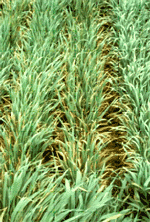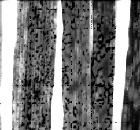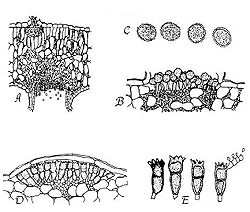| Crown rust (or leaf rust) of oats is caused by the
fungus Puccinia coronata var. avenae. It infects the Illinois oat
crop almost every year (Figure 1). Several specialized varieties of
the fungus attack many related grasses. The amount and severity of
infection varies greatly from year to year, depending on weather conditions,
the amount of rust inoculum (spores) present, and the acreage of susceptible
varieties.
In a year of heavy attack by crown rust, 90 to 100 percent of all
oat plants growing in Illinois become diseased, and the rust reduces
the food-manufacturing ability of the leaves by up to 30 percent.
Dry weather and/or cool or hot weather is unfavorable for rust infection,
resulting in little or no crown rust developing in the state.
Over a 25-year period in Illinois, the annual loss from crown rust
has ranged from a trace to 20 percent of the potential yield. In
some years crown rust causes a greater loss in terms of yield and
grain quality than any other oat disease. Heavily rusted plants
are prone to have extreme water loss from hot dry winds, due to
rupturing of plant tissues by the rust pustules. This water stress
can result in premature ripening, lower yield, shriveled grain,
lower test weight, and lodging.
|

Figure
1. Oat field severely infested with crown rust (S.G. Jensen).
|
Symptoms
Rust may appear on oats in southern Illinois as early as late April.
Small, scattered, oval-to-oblong, bright orange-yellow pustules
(uredia) develop–principally on the leaves. Similar pustules
may occur on the leaf sheaths, stems (culms), and panicles. The
uredia soon burst through the epidermis to release a dusty mass
containing many thousands of microscopic, orange-yellow summer spores
(urediospores).
Crown rust is distinguished from stem rust of oats by the bright,
orange-yellow color, the smaller size of the pustules, plus the
lack of conspicuous, jagged fragments of oat epidermis adhering
to the sides and ends of the pustules.
The number and size of the crown rust uredia vary greatly, depending
on the susceptibility of the oat variety and the severity of infection.
If the weather is favorable for infection–high humidity, fogs,
frequent heavy dews or light rains, and a temperature of 70 F or
above–the pustules become numerous and may merge as the season
progresses. A new generation of urediospores may be produced every
7 to 10 days depending on the weather. These spores, in turn, are
blown about by air currents–spreading the disease from plant
to plant and from field to field as long as growing oat plants are
available.
As the oat plants begin to ripen, the black overwintering spores
(teliospores) are formed in telia (Figure 2). These spores also
may form earlier in the season during periods of adverse weather,
such as extreme drought, excessive moisture, or very high temperatures.
Teliospores, seen under the microscope, have crownlike appendages
at their apex and it is this feature that gives the disease its
name. The teliospore stage does not rupture the epidermis. The telia
are grayish-black to black, oblong, slightly raised, and most abundant
on the leaf sheaths. Many telia may be arranged in rings around
the pustules of the urediospore stage.
|

Figure
2. Close-up of crown rust on oat leaves.
|
Disease Cycle
In many aspects, the disease cycle of the crown rust fungus is
similar to that of stem rust. The thick-walled, black teliospores
(Figure 3E) germinate in the early spring to produce other minute,
delicate spores (sporidia or basidiospores) that are carried by
the wind in a viable state up to about a half mile, infecting only
the young leaves of rust-susceptible buckthorns (Rhamnus spp). On
buckthorn, bright yellow-to-orange spots appear on the upper leaf
surface in April (southern Illinois) or May (northern Illinois)
which contain pycnia (Figure 3A). Each pycnium produces pycniospores
and special aerial mycelium called receptive hyphae. The pycniospores
are exuded from the pycnia in a thick, sweet liquid which attracts
insects. Pycniospores ar carried by insects or splashed by water
from one pycnium to another, where they become attached to the receptive
hyphae. The nuclei from the pycniospores enter the receptive hyphae
and fuse. This later results in the formation of an aecium (Figure
3A) opposite the pycnia (usually on the lower leaf surface) which
are seen as raised, round to somewhat irregular, orange-yellow "cluster
cups" (Figure 4). Aeciospores formed in the aecia may differ
genetically from either pycniospores or receptive hyphae. This exchange
of genetic material may result in the formation of new races of
the pathogen. The aeciospores are carried by air currents and infect
only oats. Each infection gives rise to a uredium (Figure B) 7 to
10 days later in which urediospores (Figure 3C) are formed. Generally,
new generations of urediospores reinfect oats until the crop matures
and the black teliospores are formed again.
Urediospores produced on oats and grasses in Illinois and other
northern states are blown south in the autumn, where they infect
winter oats and grasses grown for grain and pasture in northern
Mexico and the southern United States. In southern oat-producing
areas, the rust fungus recycles continuously in the urediospore
stage. In the spring, the spores produced on oats and grasses in
the south are carried northward by the wind, sometimes hundreds
of miles, to infect oats in Illinois and other northern states as
the crop begins to grow. In this case, the rust fungus does not
require buckthorn as an alternate host. The damage caused in Illinois
by wind-blown rust from the south varies from year to year. The
losses depend on the amount of rust that overwinters in the south,
the northern extent of the overwintering areas, the weather conditions,
and the susceptibility and stage of growth of the Illinois oat crop
when the spores arrive.
Crown rust usually appears on oats near buckthorn plantings 3 to
4 weeks before crown rust urediospores are blown into Illinois from
the south. These early infections commonly result in the worst damage.
Rust-Spreading Buckthorns
There are two principal species of rust-spreading buckthorns in
Illinois: the common buckthorn and the lance-leaves buckthorn. These
two buckthorn species are on the noxious weed list in Iowa.
Common Buckthorn (Rhamnus cathartica). A treelike shrub introduced
into the United States from Europe, the common buckthorn has been
widely planted for windbreak, hedge, and ornamental purposes. Birds
spread the seed. In many counties, common buckthorn can be found
growing in fence rows, wood lots, and timbered areas, and along
roadsides. Common buckthorn ranges in height from 5 to 25 feet.
It has glossy, dark-green leaves with 3 to 5 pairs of veins. Small,
single thorns are usually found on the branch tips and in the crotches.
Common buckthorn has round, pea-sized berries that are green in
sumemr and black in autumn and winter. The bark is black, usually
quite smooth, and yellow inside.
Lance-Leaved Buckthorn (R. lanceolata). The native lance-leaved
buckthorn differs from the common species by having lance-shaped
leaves with 6 to 8 pairs of veins. The berries are egg-shaped.
Physiologic Races
Several hundred distinct pathogenic strains or races of the crown
rust fungus are known to attack oats. These races differ only in
their ability or inability to attack different oat varieties. No
cultivated variety is immune to all races. Fortunately, only a few
races are usually present in large numbers during any one year in
Illinois. When virulent races to which the varieties being grown
are susceptible begin to build up, a switch to other varieties becomes
necessary. Consequently, the recommendations on oat varieties are
in a state of flux, depending on the prevalent rust races. Since
about 1930, oat breeders and plant pathologists have constantly
been developing and releasing new varieties that are resistant to
more and more races of crown rust. The battle is a never-ending
one.
Like barberry for the stem rust fungus, buckthorn serves as a source
of development for new races of crown rust. As far as is known,
new races of crown rust originate only on buckthorn by cross-fertilization
of existing races.
|

Figure
3. Disease cycle of Puccinia coronata, the crown rust fungus,
as it appears under a microscope. A, vertical section through a
common buckthorn leaf showing a flask-shaped pycnium with receptive
hyphae on the upper surface and on aecium or "cluster-cup"
(with chains of aeciospores, some being released) on the lower surface;
B, section through a uredium on an oat plant with a layer of stalked
urediospores which have ruptured the epidermis; C, four urediospores;
D, section through a telium on an oat plant with a layer of teliospores
which has raised the epidermis; E, four teliospores with crownlike
appendages at their apex. The teliospore to the right has germinated
to produce four basidiospores or sporidia.
|
Control
|
1. Grow the crown rust-resistant and early maturing varieties currently
recommended by University of Illinois Extension Agronomists and
your nearest Extension adviser as adapted to your locality. Refer
to the Illinois Agricultural Pest Management Handbook which is revised
annually and should be available in your nearest Extension office.
Oat varieties that mature early frequently escape moderate to severe
damage by crown rust. Research is under way to develop new and improved
varieties that will be more resistant to or tolerant of crown rust.
2. Plant oats as early as practical in the spring. This helps the
crop escape infection by rust.
3. Whenever possible, eradicate rust-spreading buckthorn shrubs
growing within a mile of oat fields. The following methods are the
best ones for eradication:
a. Dig or pull out the plants with a bulldozer or tractor and chain.
If regrowth occurs, spray it to runoff with a herbicide suggested
by University of Illinois Extension Agronomists and your Extension
adviser.
b. Kill standing buckthorn shrubs or trees with a basal herbicide
spray treatment at any time during the year. Spray the basal 15
inches around the trunk to runoff. This treatment is not desirable
around farm buildings, because it leaves dead plant material standing.
c. Cut the buckthorn plants off near the ground level. Apply a
suggested herbicide to the cut stumps.
4. If crown rust is building up rapidly–particularly on late
plantings or late-maturing oat varieties–it may be wise to
harvest the crop for silage to maximize the feed value of the crop.
Cutting the crop when it is in the soft-dough stage usually makes
silage of the best quality.
5. Aerial application of a foliage-protecting fungicide may be
warranted. These conditions would apply if:
a. The yield potential and value of the crop are high.
b. The oat variety is susceptible to crown rust and/or Septoria
disease and to Helminthosporium leaf blotch.
c. Leaf diseases have an early start.
d. The long-range weather forecast is for continued moist weather.
The EPA-approved fungicides are largely protective, and should
be applied to oat foliage when disease is first seen and before
it destroys the leaf, leaf sheath, culm, and panicle tissues.
Using a properly equipped aircraft–fixed wing or helicopter–is
the best way of applying a fungicide to the crop. Select an aerial
operator who is familiar with disease control and whose aircraft
has been properly calibrated for uniform, thorough coverage of all
aboveground plant parts. A proper application requires a minimum
of 5 gallons of water per acre in order to cover the foliage uniformly.
For further information refer to Illinois Agricultural Pest Management
Handbook. Be sure to read the fungicide label and follow all directions
carefully. It is advisable to add a commercial spray adjuvant (surfactant)
to the spray mix to help disperse the fungicide and improve coverage.
|

Figure
4. Close-up of ‘cluster-cup" stage of crown rust on
the underleaf surface of buckthorn.
|
The time of application is critical, and will vary from area to area
and season to season. Normally, the first application on oats is made
between the time the panicle emerges from the boot and the early milk
stage. The second spray should follow 9 or 10 days later. If crown rust,
Septoria disease, or Helminthosporium leaf blotch appears before the panicle
emerges, move the first spray up about a week to 10 days. Keep the flag
leaf as disease-free as possible until after the kernels have filled.
Follow label directions as regards the interval between the last fungicide
spray and harvest.
When spraying oats with a foliar fungicide the first year, spray only
half the acreage. Measure the acreage treated and record the yield and
bushel weight from this area. Measure an adjacent area and leave it unsprayed.
Record the yield and test weight from the unsprayed plots and compare
the figures with those from the sprayed area.
For Successful Fungicide Application
1. Grow only the best oat varieties. These also should be resistant to
the barley yellow dwarf virus.
2. Watch the stage of growth and check for early disease symptoms.
3. Spray where high yields are expected.
4. Make arrangements with your aerial applicator as early as possible.
5. Be sure the aircraft can apply 5 gallons of water per acre in a uniform
spray pattern.
6. Protect the crop before disease destroys the leaves. Spray on time.
7. Make two applications of a recommended fungicide plus a spray adjuvant.
Normally, the first spray would be applied sometime from the early heading
stage (when the panicle is beginning to emerge from the boot on 25 percent
of the plants) to the early milk stage–with the second application
(if needed) 9 or 10 days later.
8. Be sure to measure and compare the yields and bushel weights of both
the sprayed and unsprayed areas.
Back to Top
|



